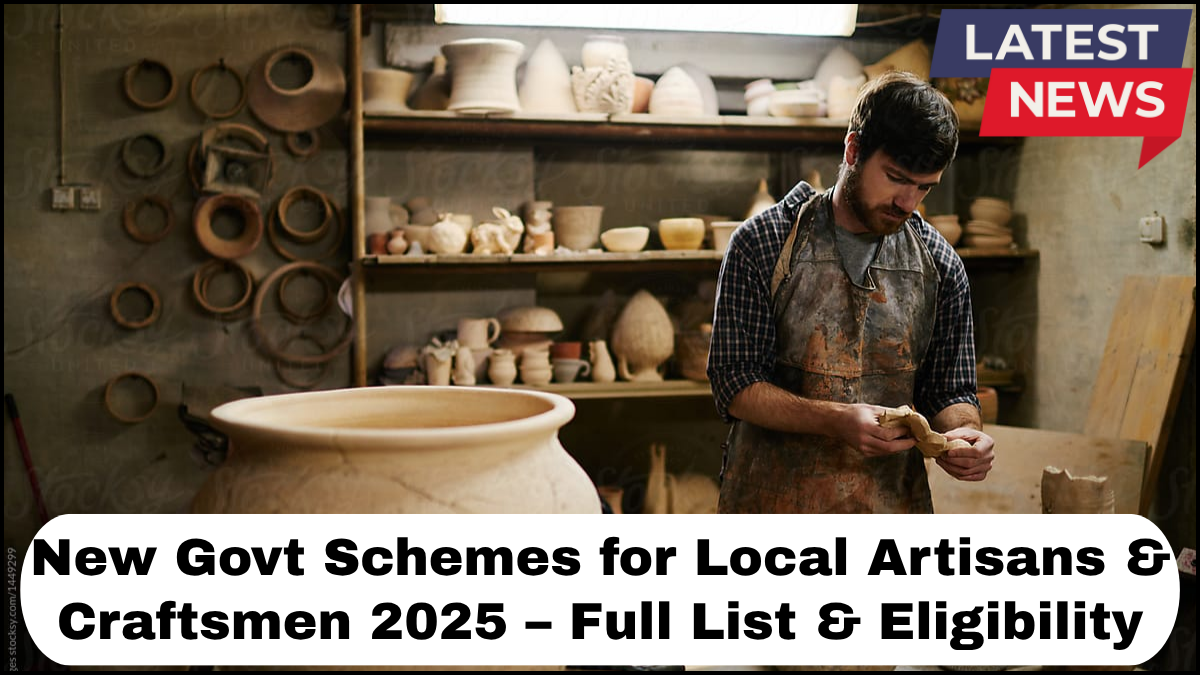The Indian government has rolled out a fresh wave of Artisan Welfare Schemes in 2025 aimed at uplifting local artisans and craftsmen. These initiatives are designed to address the challenges faced by those engaged in traditional crafts and rural industries, ensuring sustainable livelihoods, skill development, and market access.

Here’s a comprehensive breakdown of the newly launched schemes, their benefits, and how artisans can qualify.
1. Vishwakarma Kala Samman Yojana (VKSY)
Overview: This flagship scheme aims to identify, support, and promote master artisans in various traditional art forms across India.
Key Features:
- Monthly stipend of ₹5000 for selected master artisans
- Annual grants up to ₹10 lakhs for setting up training workshops
- International exposure through participation in global handicraft expos
Eligibility Criteria:
- Must be a recognized artisan with a minimum of 10 years of experience
- Proof of practicing traditional art/craft form
- Registration with a local or national artisan board
2. Gramin Hastkala Udyog Vikas Scheme
Overview: Focused on rural clusters, this scheme promotes collective growth and modernization of artisan hubs.
Key Features:
- Infrastructure grants for common facility centers
- Toolkits and modern equipment provision
- Digital literacy and e-commerce training
Eligibility Criteria:
- Registered artisan SHG (Self Help Group) or cooperative
- Minimum 25 active artisan members
- Operating within a recognized handicraft cluster
3. Kaushal Kala Vikas Abhiyan (KKVA)
Overview: This skill development initiative enhances the productivity and market-readiness of young artisans.
Key Features:
- Free training programs in traditional crafts and modern design trends
- Certification by NSDC (National Skill Development Corporation)
- Placement support and entrepreneurship training
Eligibility Criteria:
- Aged between 18-35 years
- Belonging to artisan families or rural craft backgrounds
- Basic education up to 8th standard
4. Handicraft Credit Support Scheme (HCSS)
Overview: To ensure easy and timely access to credit, HCSS offers low-interest loans to artisans.
Key Features:
- Credit up to ₹2 lakhs at 4% interest rate
- No collateral required for loans up to ₹50,000
- Interest subsidy for prompt repayment
Eligibility Criteria:
- Valid artisan ID card issued by Development Commissioner (Handicrafts)
- No outstanding defaults with any financial institution
- Active in craft production for the last two years
5. National Artisan Digital Market Integration Program (NADMIP)
Overview: This digital push connects artisans directly with buyers through government-backed platforms.
Key Features:
- Onboarding on GeM (Government eMarketplace) and India Handmade portal
- Product photography and catalog creation support
- Real-time order and payment tracking
Eligibility Criteria:
- At least 1 product line ready for market
- Basic smartphone access
- Willingness to participate in online training
Promoting Handicraft Through Holistic Support
These Artisan Welfare Schemes go beyond financial aid. They incorporate handicraft promotion through marketing, branding, and digitization. Exhibitions, state-level fairs, and global artisan exchange programs are being actively promoted to ensure Indian crafts gain visibility and value.
In addition, state governments have been encouraged to align their local initiatives with these central schemes, ensuring wider coverage and deeper impact. Government departments are also collaborating with NGOs and private partners for scheme implementation and monitoring.
Frequently Asked Questions (FAQs)
Q1: How can I apply for these Artisan Welfare Schemes?
A: Applications can be submitted through the MyMSME portal, the IndiaHandmade website, or district handicrafts offices. Offline application counters are also available in craft clusters.
Q2: Are these schemes only for traditional artisans?
A: Primarily yes, but certain schemes like KKVA and NADMIP also encourage semi-skilled or young entrants into artisan trades.
Q3: Can women artisans avail these benefits?
A: Absolutely. In fact, most schemes have a special quota or additional incentives for women artisans and SHGs led by women.
Q4: Is Aadhaar mandatory to enroll?
A: Yes, Aadhaar-based authentication is generally required for verification and DBT (Direct Benefit Transfer) purposes.
Q5: Can urban artisans apply?
A: Yes, while the focus is on rural artisans, urban craftsmen practicing traditional art forms are also eligible under most schemes.
click here to learn more